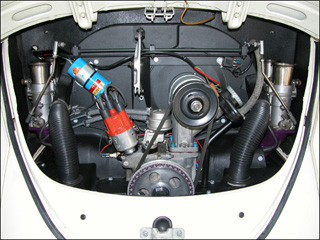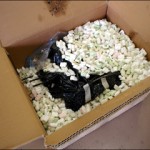
05 May Adding Bump to Your Stick and Squish to Your Dish Part I
That was it – I was hooked! After making 6 passes down the quarter mile track, my car suddenly felt slow. I wanted more, and I wanted it now! Such is the pathetic nature of human beings that we adapt to stimuli too easily, requiring more stimuli (horsepower) to feel the thrill we once felt.
The Big Picture
 The purpose of this four-part series of articles is to show you the detailed process of building a performance engine; in particular, performing maintenance and modifications to an existing engine and assessing the difference. In Part I, we’ll look at the process of tearing down an engine and some of the things to keep in mind along the way. In Part II, we’ll look at the process of inspecting and machining engine parts. In Part III, we’ll look at the process of reassembling the engine. In Part IV, we’ll look at the before and after impact of the changes, both subjectively (how it feels) and objectively (performance numbers).
The purpose of this four-part series of articles is to show you the detailed process of building a performance engine; in particular, performing maintenance and modifications to an existing engine and assessing the difference. In Part I, we’ll look at the process of tearing down an engine and some of the things to keep in mind along the way. In Part II, we’ll look at the process of inspecting and machining engine parts. In Part III, we’ll look at the process of reassembling the engine. In Part IV, we’ll look at the before and after impact of the changes, both subjectively (how it feels) and objectively (performance numbers).
Originally built in 1994 for my daily-driven 1971 Super Beetle convertible, the 2017 cc (78.4 mm x 90.5 mm) engine featured here was intended for a heavy daily driver with tall gearing (3.88 R&P and .89 4th) that was used for long distance driving and occasionally called upon to pull a small 12-foot boat. Running stock VW doghouse tin, a Holley Bugspray carburetor, 009 distributor, un-ported CB 044 heads with 40 mm x 35 mm valves, Weber 256H hydraulic cam with VW 1.1:1 rockers on bolt-together shafts, full-flow filtering, 7:1 compression and an 1 3/8″ header with single Quiet Pack muffler, this motor performed flawlessly returning tremendous reliability and good fuel economy for approximately 50,000 kms (31,000 miles).
 The engine was removed from the 1971 convertible for installation in my 1967 Beetle in 1998. Wanting more performance, the heads were removed and a set of used Jeff Denham-ported VW 043 heads were installed with 40 mm x 37.5 mm valves, the compression was raised to 8.2:1, the header was replaced with a 1.5″ inch unit, and Weber 48 IDA carburetors were installed with 37 mm venturies. These changes yielded a significant increase in torque and horsepower, making it a pleasure to drive, yet continued to provide reliability and fuel economy for an additional 30,000 kms (15,000 miles).
The engine was removed from the 1971 convertible for installation in my 1967 Beetle in 1998. Wanting more performance, the heads were removed and a set of used Jeff Denham-ported VW 043 heads were installed with 40 mm x 37.5 mm valves, the compression was raised to 8.2:1, the header was replaced with a 1.5″ inch unit, and Weber 48 IDA carburetors were installed with 37 mm venturies. These changes yielded a significant increase in torque and horsepower, making it a pleasure to drive, yet continued to provide reliability and fuel economy for an additional 30,000 kms (15,000 miles).
As noted above at the outset, however, I still wanted more, but was limited by the existing camshaft. With only .312″ of lift at the intake valve, I was severely limited by the amount of air I could ingest into the engine; the good flowing cylinder heads were being completely wasted! The mild duration of the camshaft further limited air intake and additionally, would not tolerate any more compression due to the high dynamic cylinder pressure caused by the mild cam overlap. The answer? Tear the engine down to have a more suitable cam installed, providing more lift, duration (and overlap), which would allow a subsequent increase in the compression ratio. Given the mileage of the engine (80,000 kms or 50,000 miles), this would also be a good time to inspect the engine and perform any required maintenance.
 The goal was to end up with an engine producing great power (approximately 150 HP at the flywheel) and torque, without giving up drivability and reliability. An engine that could be driven like a kitten on long trips, yet roar like a lion at the drag strip!
The goal was to end up with an engine producing great power (approximately 150 HP at the flywheel) and torque, without giving up drivability and reliability. An engine that could be driven like a kitten on long trips, yet roar like a lion at the drag strip!
Decisions, Decisions…
Once you’ve made a decision to have high performance engine work done, you generally have two options:
1. Build it yourself, buying the parts and relying on a machine shop to perform all of the necessary machine work; or,
2. Pay a professional engine builder to do the work.
Both have their merits, and you need to decide which option meets you needs, based upon your budget (can you afford to pay labour?) Time (do you have the time and interest to build the engine, and if so, will it be done within the timelines you need?) Use your brain (not your ego) when making these decisions, and be sure to plan your budget; quality high-performance engines are not cheap, and cutting corners on quality parts and/or labour will always be more expensive in the long run. If you don’t have the money now, it’s better to save for a bit longer than to compromise the result. As the saying goes, there are three types of engines: those that are inexpensive, those that produce power, and those that are reliable. You can only have two of those elements at one time, never three.

